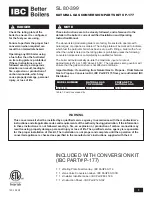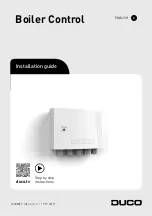
29
The E20 remote control can also be used to select the maximum flow temperature for heating
circuit 1 and to programme the desired heating times and room temperature. The E20 remote
control will switch the heating function of this circuit on and off in accordance with the heating
times and room temperatures programmed.
NOTE:
For mixed underfloor heating circuits, we recommend selecting a maximum flow
temperature NO HIGHER THAN 45 ºC, to protect the underfloor heating installation from
overheating.
10.3
DHW mode functioning
The E20 remote control can be used to select up to two DHW temperatures and the desired DHW
production times. The E20 remote control regulates the DHW tank temperature at each particular
time, and enables or disables the DHW function according to the times scheduled.
The E20 remote control also has an option for enabling a function to protect against legionella
bacteria (see instructions enclosed with the E20 remote control).
10.4
Telephone relay function
The E20 remote control is designed for connection to an external telephone relay. If a telephone
relay is connected to the E20 remote control, the heating mode of heating circuit 1 and the DHW
mode can be switched on and off from anywhere in the world, simply by making a telephone call
(see instructions enclosed with the E20 remote control).
11
SHUTTING DOWN THE BOILER
To switch off the boiler, place your finger on the power touch button
(25)
for 1 second. In
Off mode
,
while the boiler is plugged into the mains and connected to the fuel installation, its heating and DHW
functions will be switched off but the anti-frost protection and pump anti-block functions will remain
activated.
To shut down the boiler functioning completely, unplug it from the mains and cut off the fuel supply.
12
DRAINING THE BOILER
The water is drained from the boiler by opening the air drain valve
(1)
inside the boiler (on the lower
right hand side on opening the door). Connect a flexible tube to this valve and run it to a drain. After
draining the boiler, close the valve again and remove the flexible tube.
13
DRAINING THE SOLAR CIRCUIT
If you need to drain the solar circuit, connect a hose to the solar accumulator drain valve
(2)
and run
the hose to a suitable container (minimum capacity 19 litres), so that the heat-carrying fluid can be
reused if necessary. Open the drain valve and the level valve. After draining the circuit, close the shut-
off valves and disconnect the hoses.
















































